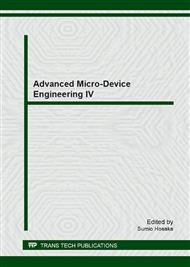p.8
p.15
p.21
p.26
p.31
p.35
p.43
p.50
p.55
Composition Dependence of the Glass Network Structure in Li+-ion Conducting Glasses of (LiCl)x(LiPO3)1-x Studied by 31P MAS NMR
Abstract:
In order to obtain information about the structure of a typical Li+-ion conducting glass of (LiCl)x(LiPO3)1-x, 31P MAS NMR measurements were performed for the glass samples with different LiCl compositions x from 0 to 0.4. NMR spectra of the samples indicated the existence of two kinds of P atoms; one is that within the-P-O-P-O-P-chain of LiPO3, P(Q2), and the other is that at the ends of the chain, P(Q1). The ratio of the amount of P(Q1) to that of P(Q2) was observed to increase with the increment of x. The result shows that the addition of LiCl to the glass former of LiPO3 changes the glass network structure by cutting P-O bonds in one-dimensional phosphate chain, and the increment of the Li+-ion conductivity with the increase of x is concluded to be brought not only by the increase of the amount of LiCl dissolved into the interstices between the phosphate glass networks but also by the dispersion of the phosphate glass network structure.
Info:
Periodical:
Pages:
31-34
Citation:
Online since:
December 2013
Authors:
Price:
Сopyright:
© 2014 Trans Tech Publications Ltd. All Rights Reserved
Share:
Citation:


